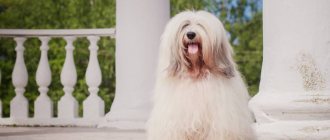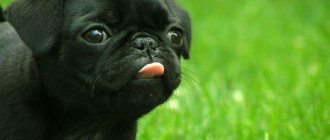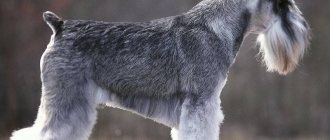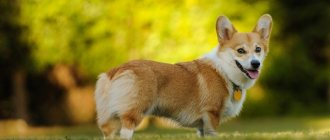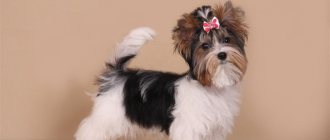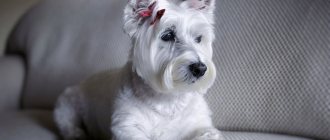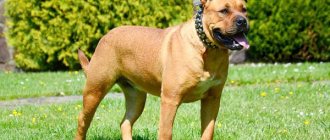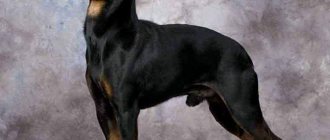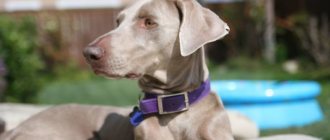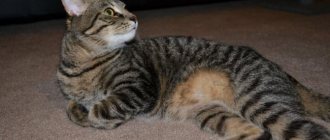History of the breed
A true native of Tibet
Today it is impossible to say when the Lhasa Apso appeared - a breed of dog considered a talisman and amulet of Tibetan monks. Yes, it was bred in Tibet, but it gained popularity after the British officer Frederick Bailey brought several dogs to his homeland, from where it spread throughout Europe, and then throughout the world.
Fact! The name of the breed consists of two parts: Lhasa is the capital of Tibet, and apso is translated from the local language as “beard”. That is, the name can be translated as “bearded man from Lhasa.”
The IFF recognized the breed in 1960 and since then Lhasa dog exhibitions have been held in different countries.
Description of the breed
In general, the Tibetan Apso dog is quite compact. The height of males is about 27-28 cm, and that of females is 25-26. The weight is also small - 6-8 and 5-7 kg, respectively. Such characteristics make the pet an excellent choice for small apartments.
Breed standard
Of course, if the reader likes the Lhasa Apso, the description of the breed should definitely be studied in order to choose a pet that ideally meets all accepted standards:
- The head is quite narrow; in the upper part the skull gracefully makes the transition from the forehead to the tubercle of the back of the head. Not too flat, but at the same time not domed. Straight bridge of the nose. The length of the muzzle is about 4 cm - about a third of the entire length of the head.
- Jaws and teeth. The incisors of the upper jaw are pressed against the incisors of the lower jaw, and are located behind them. This creates a reverse scissor bite. The line of incisors is wide and straight. A positive factor is the presence of a full set of teeth.
- The nose is quite fleshy, always black.
- The eyes are dark, oval, set straight, and of medium size. Convex ones, as well as those planted too deep, are undesirable. The whites are not visible either at the top or near the base.
- The ears are drooping and large for such a compact skull. Densely covered with soft, long hair.
- The neck is gracefully curved, long, neatly flowing into the back.
- Frame. Many experts note that the Lhasa is a dog with a balanced, compact, but strong body. The loin is strong and the top line is straight. The ribs extend backwards.
- Limbs. The shoulder blades of the forelimbs are located obliquely. The straight forearms are thickly covered with fur. The hind legs boast well-developed muscles, as well as good articulation angles. This provides the dog with amazing jumping ability. Long, thick hair tightly covers the limbs.
- The tail is set high and extends behind the back, but at the same time does not curl into a ring. A good coat of fur is a must. In some cases, a kind of “hook” is observed at the tip of the tail.
- Wool. The undercoat is moderately developed. The outer coat is straight, long and heavy. It has a dense texture, and not at all silky or fluffy, as it may seem from the photographs.
- Color. Different color options are acceptable: white, brown, sand, gold, honey, smoky, black, bluish-gray and dark gray. A two-tone color that combines two of the above shades is not considered a defect.
Disqualifying faults
A dog may be disqualified if it demonstrates any deviation from the above standard. Also, the reason for disqualification is cowardice and increased aggressiveness.
It's immediately obvious that this is a royal person
Health and disease of the Lhasa Apso
Possible diseases
With proper care, dogs rarely get sick. Their immunity is strong. Miniature Lhasa dogs are characterized by:
- kidney diseases of varying severity;
- problems with the functioning of joints, especially the hip;
- inflammatory processes in the ears, eyes;
- allergies from the presence of parasites in the body.
Most often, representatives of the breed suffer from a genetic disease associated with eye inflammation. The eyes require periodic examination. Peeling or other allergic reactions may often appear on the skin due to thick fur. It is important to detect skin lesions in time and contact a veterinarian.
Reproductive health
Before you start breeding puppies, it is recommended to contact a club that sells individuals of this breed. This is necessary so that in the future there will be demand for your broods, that is, there will be buyers.
On average, females are in heat for 21 days, with a break between cycles of 6-10 months. But there may be individual deviations, since all dogs are different. The most suitable age for mating is 2.5-5 years. Before mating, it is important to undergo an examination, take smears for tests, expel worms if they are present in the body, and adjust the bitch’s diet.
It is best to do this 1-2 months before the start of estrus. From 7-8 days you need to check the color and consistency of the discharge using a cotton swab. When the color becomes pale pink or completely transparent, you can start knitting.
It is recommended that a pregnant bitch be given vitamin complexes prescribed by a veterinarian. You should not severely limit her activity or change her diet. Only towards the middle of pregnancy should you increase the portion size, but not by much.
Advantages and disadvantages
If we talk about the advantages of the Lhasa Apso, the breed can boast of:
- a flexible mind that provides excellent learning ability;
- cheerful disposition;
- suitable character and size for keeping in an apartment;
- devotion to the owners.
But this is not without its drawbacks. To begin with, they do not get along very well with children. The dog, despite its small size, will not tolerate excessive freedom in relationships.
Such a pet is quite expensive due to the rarity of the breed. Finally, you will have to regularly go to a specialist for haircuts - the hair grows back surprisingly quickly.
Character
The character of the Lhasa Apso is cheerful, it seems that the pet was created for fun. However, he behaves this way only with the owner, his family. These little dogs have a desire for independence, which sometimes manifests itself even at home. Sometimes this interferes with education. Funny pets with big eyes and long fur coats look very comical when they demonstrate their independence.
Lhasa Apsos are considered one of the most loyal breeds. Dogs cannot do without the attention of their owner. Long separation and loneliness have a negative impact on the physical and emotional health of the pet. In return for selfless love for the owner, he will expect the same attitude towards himself.
Some people mistakenly believe that the Apso is a breed that, like many toy dogs, will sit in their hands for days. Cheerful, active pets do not like a passive lifestyle, so this temperament is not typical for them.
The fighting nature of small dogs makes it possible to use them for security purposes. If your pet is alone at home when a stranger comes in, he will bite him without hesitation. In foreign countries, the practice of using Apso dogs as guide dogs began.
Education and training
Training such a dog is a real pleasure, because he literally grasps everything on the fly. But at the same time, the lessons should not be too long - the pet quickly gets tired and begins to openly indulge.
But upbringing must be tough. As already mentioned, the Lhasa Apso has a tendency to selfishness, so it will definitely try to sit on its owner’s neck if he allows it. It is important to ensure that the dog follows the rules established by the owner and suppress any attempts to change the balance of power.
The star of any exhibition
How to choose a puppy
Hereditary diseases are increasingly being discovered in Lhasa Apso, so it is important to take a responsible approach to choosing a puppy. You need to choose a trusted nursery that offers puppies only with documents. The puppy should have soft, shiny fur, which is its pride.
You need to pay attention to the appearance of the puppy not only because of the aesthetic issue. The condition of the dog's fur, ears, and other organs can be used to judge the health of the dog.
If you plan to take part in exhibitions and competitions, the puppy's pedigree is important. Awards and other achievements of the dog's parents testify to its inclinations and characteristics. If you are planning to just have a pet, you can buy a puppy “in your arms”.
Comparison of breeds
The Lhasa Apso is often compared to the Shih Tzu. Both breeds are decorative and have an attractive appearance. In fact, Lhasa and Shih Tzu have significant differences:
| Lhasa | Shih Tzu |
| Active in the house, love fun games, active sports | They prefer to sleep longer, lie in their place, without touching anyone |
| Tend to be trained using only certain training methods | Prone to training with almost any program |
| Prefer to communicate with the owner, family | Sociable with strangers |
| May show aggression towards children if they are offended | Differ in tolerance |
| Not suitable for families with small children | Suitable for families with small children |
| Suitable for business use | Not suitable for business use |
Pros and cons of the breed
The following are the advantages and disadvantages of the Lhasa Apso:
| + | — |
| Attractive appearance, beautiful fur coat | Special care required |
| Opportunity to participate in exhibitions and competitions | The need to visit grooming salons |
| High intelligence, fast learner | Independence, leadership skills |
| Security skills | Not suitable for families with small children |
| Possibility of raising a guide dog | Not suitable for outdoor living |
| Active, cheerful, funny | Difficult to find in Russia |
| Suitable for apartment living |
Hygiene
In order for your dog to feel good and look great, you need to provide him with appropriate care:
- combing – 2-3 times a week;
- bathing - every week using a special shampoo;
- brushing your teeth – once a week (there is a tendency for plaque to form and tooth decay);
- ear cleaning – twice a week;
- Cleaning your eyes every day.
With this approach, there will be no unnecessary problems with keeping the Lhasa Apso.
Features of care
Combing
The Lhasa Apso's coat should be closely monitored. It must be carefully combed out with a furminator ; when it grows so long that it drags along the floor, it must be trimmed.
You should bathe as needed, but at least once a month. You can take your dog to professional grooming .
If you want to cut your dog's hair yourself, we recommend that you read the article
In order to protect the eyes and ears from inflammation and infections, you need to regularly inspect them and clean them as needed.
Important! As soon as the dog's claws begin to rattle on the floor, it is worth cutting them off.
At the same time, it is necessary to shorten the fur between the toes, carefully cutting off the pads.
The Lhasa Apso is a hardy companion. This baby is ready for hikes of any complexity and duration.
Walk
The Lhasa Apso is a domestic breed; a one-time daily half-hour walk is enough for the dog to relieve accumulated energy.
You should not practice agility - it will become overtired. These breeds require very gentle walks.
Important! After each walk, you need to examine the dog's skin. Parasites should not be allowed on the body; the Apso is very sensitive to them.
Thanks to their vigilance and caution, Lhasa Apsos are still used as guard dogs in Tibet.
Nutrition
Lhasa Apso puppies grow faster than most babies of man's best friend.
Therefore, it is worth consulting with the breeder about their diet, because the dog’s menu must be sufficiently high-calorie and saturated so that its body can develop harmoniously.
At 8 months, the young “Tibetan” already looks like an adult.
Feeding regimen by age:
- Up to 3 months – 5 times a day
- Up to 5 – 4 times
- Up to 7 – 3 times
- From 8 and older – 1-2 times
You should never give, either a puppy or an adult dog, sweet, fatty, salty, smoked, spicy, hot, all kinds of sausages.
Lhasa Apso puppies grow faster than most babies of man's best friend. At 8 months, the young “Tibetan” already looks like an adult
It’s good if the owner uses special dry food and canned food for feeding.
This approach greatly simplifies the preparation of a balanced menu.
If you decide that your dog’s diet will be made from natural products, make sure that it contains the following:
- lean meat and offal;
- boiled sea fish without large bones;
- boiled chicken meat with fat removed;
- dairy products;
- buckwheat and rice;
- all vegetables, except starchy ones and legumes.
You can't leave your dog alone for a long time. Moreover, Apso not only loves to communicate, he likes to be the center of attention
